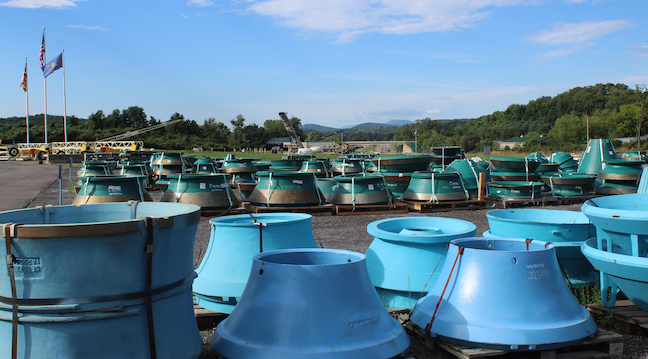In the late 1800s, Sir Robert Hadfield, a British metallurgist, was seeking a way to make steel alloys less brittle. It took years, but after trial and error and countless tests, he was finally able to develop a material that didn’t break from heavy impact.
The metal he used to accomplish this feat was manganese.
Atomic number 25 on the periodic table, manganese is one of the most common transition elements in the earth’s crust. While it’s hard, it’s also very brittle; it wasn’t until Hadfield combined it with steel that its industrial uses became apparent. Fast forward to today, and manganese is used in steel alloys all across the aggregate industry – and it’s particularly useful in wear part applications. It’s not one-size-fits-all, though; alloys with different levels of manganese content have different characteristics.
As we’ve written before, it’s crucial to get the correct wear parts for your rock crushing operation. As you consider manganese parts, here’s how to choose the right ones.
Why Are Wear Parts Made with Manganese?
Let’s start with the basics – why should you choose manganese wear parts for your crushing operation at all?
The basic answer (that Hadfield uncovered long ago) is that manganese alloys are work-hardening metals– meaning that the harder you hit them, the harder they get. In wear part applications, material is hit over and over and over, so manganese steel is ideally suited for durability in this role. It’s been used accordingly for more than a century. Importantly, though, while higher manganese content in an alloy makes it harder, it also makes it more brittle.
The upshot of this is that pure manganese doesn’t make for good wear parts; instead, different ratios of manganese are used (along with steel and other materials) for different applications.
Factors That Impact Wear Part Requirements
When choosing manganese wear parts, the three most important considerations are:
What kind of material is being crushed? Is the rock hard (granite) or soft (limestone, sandstone)? What size is it being crushed to? How has material been prepped? If material is being recycled, is tramp metal included?
What is being produced? What is the final size of the product?
What kind of crusher is being used?Is it a jaw or cone crusher? What make and model? What are the manufacturer’s specifications for wear parts?
With that in mind, here are a few of the most common manganese content levels, along with the applications they’re best used for.
11-14% Manganese Wear Parts
This represents the lower end of the spectrum. Wear parts that are 11-14% manganese are more ductile and more durable, and they’ll also work-harden the fastest. This means that they’re best suited for very low abrasion, lower strength rock.
18% Manganese Wear Parts
This represents the middle of the spectrum. 18% manganese wear parts are middle-of-the-road when it comes to abrasion resistance and the rate at which parts work-harden.
As a result, 18% manganese is one of the most commonly used ratios. Outside of limestone, it works for the majority of applications.
22-24% Manganese Wear Parts
Finally, 22-24% manganese wear parts represent the high end of the spectrum. At this level of manganese, wear parts are brittle, and so they’re only suited for high abrasion material that’s even more brittle.
How Mellott Can Help You Procure the Right Parts
As you can see, there’s a lot that goes into selecting the right manganese wear parts for your crushing application. The good news for many crushing operations is that if you’re ordering wear parts, you’re likely replacing worn out ones, so you should know the specifications of your replacement parts.
If this is the case (or if you simply know the parts you need), getting the right part is simple – just get in touch with us, and we’ll ship you the parts you need. We carry manganese wear parts for the vast majority of crusher brands and models.
If you aren’t sure what manganese wear parts you need, no worries – we can help.
Get in touch with us and our team will consult with you to determine your requirements. We’ll ask questions (like the ones listed above) and identify the parts that will best serve your needs. If you need help implementing your wear parts, we can send technicians to your site to assist with that, too.
The bottom line is that no matter your needs, we can help you identify, obtain, and implement the ideal manganese wear parts for your rock crushing application.
At Mellott, we’ve been helping the aggregate industry to meet its crushing needs for over 50 years – so we’re not quite as old as Robert Hadfield’s 1883 patent on manganese steel, but we still have a depth and breadth of expertise that’s unmatched in the industry.
If you’re looking for manganese wear parts, give us a call today to get started.

